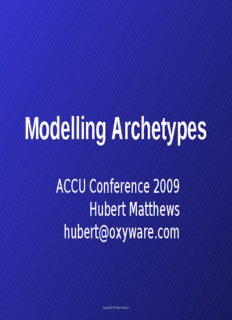
Modelling Archetypes PDF
Preview Modelling Archetypes
Modelling Archetypes ACCU Conference 2009 Hubert Matthews [email protected] Copyright © 2009, Hubert Matthews Overview • Archetypes – modelling patterns • Static data modelling • Linking to dynamic behaviour of system • Rules and constraints • Various bits of history • Extensions to SOA, ESB and other stuff Copyright © 2009, Hubert Matthews Four basic archetypes • Entities – “people, place, thing” • Transactional objects – order, loan, payment • Descriptions/specifications – title, type objects • Roles – borrower, authoriser Copyright © 2009, Hubert Matthews Entity classes • The nouns in the standard “find the nouns” approach to OO – modelled in “green” • Fairly static, eminently cacheable - No notion of time (history or future) - Have identities (name, ID, etc) • Create, read, update, delete operations - Data only; no significant business processes - “Dull” use cases – get/set, edit/manage • Often where people stop modelling (get stuck) • Examples: customer, product, warehouse Copyright © 2009, Hubert Matthews Transactional classes • Where the interesting stuff is! • Related to time (look for timestamps) or states (look for status/modes) - Can deal with history and future, timespans • High-volume, dynamic • Link entities together – modelled in “pink” • Basis of business processes • Examples: loan, order, reservation, payment - Business forms are pinks that refer to green entities Copyright © 2009, Hubert Matthews Modelling in colour • Patterns of connections between archetypes • Use colour to denote archetypes and connection patterns to guide model building multiplicity on time and metadata “hot” end in linking class no direct entity-entity link Copyright © 2009, Hubert Matthews Description/specification objects • Entities sometimes have associated information about their types • Use a description or specification object - modelled in “blue” (as in “blueprint”) - Examples: title (book), make/model (car) - Catalogues are collections of blues - Type Object pattern • Can be used to implement business and configuration rules in data - Fowler's Knowledge/Operational Split pattern Copyright © 2009, Hubert Matthews Rules in data (knowledge) associated business • Only certain types of process connector/cable pairings are valid • Use type objects to encode rules • Connection has 1:* to allow for time element • Could use direct green-green link if history/future not Fowler’s knowledge- required allowed operational configurations split (knowledge) Copyright © 2009, Hubert Matthews Modelling guidelines • Connect entities via a transaction (“pink”) - Represents a step in a business process - Has time element, rules and constraints - Allows for history and future • Connections between similar archetypes are whole-part relations (UML composition) - Multiplicity is 1 for whole, * for part - Dependent objects • “*” multiplicity on “hot” end (pink->green- >blue) - Great check on cardinality in database schemas Copyright © 2009, Hubert Matthews Simple order example Copyright © 2009, Hubert Matthews
Description: